Tea caddy
A tea caddy is a box, jar, canister, or other receptacle used to store tea. When first introduced to Europe from Asia, tea was extremely expensive, and kept under lock and key. The containers used were often expensive and decorative, to fit in with the rest of a drawing-room or other reception room. Hot water was carried up from the kitchen, and the tea made by the mistress of the house, or under her supervision.
The word is believed to be derived from catty, the Chinese pound, equal to about a pound and a third avoirdupois. The earliest examples that came to Europe were of Chinese porcelain, and approximated in shape to the ginger-jar. They had Chinese-style lids or stoppers, and were most frequently blue and white. Until about 1800 they were called tea canisters.[1]
Earlier tea caddies were made of either porcelain or faience. Later designs had more variety in materials and designs. Wood, pewter, tortoiseshell, brass, copper and even silver were employed, but in the end the material most frequently used was wood, and there still survive vast numbers of Georgian box-shaped caddies in mahogany, rosewood, satin-wood and other timbers. These were often mounted in brass and delicately inlaid, with knobs of ivory, ebony or silver. Many examples were made in Holland, principally of the earthenware of Delft. There were also many English factories producing high quality caddies. Soon the shape was made in Chinese export porcelain and its Japanese equivalent. The caddy spoon, typically in silver, was a wide shovel-like spoon for the tea, often with a scalloped bowl.
As the use of the jar waned and the box increased, the provision of different receptacles for green and black tea was abandoned, and the wooden tea chest or caddy, with a lid and a lock, was made with two and often three divisions for the actual caddies, the center portion being reserved for sugar. In the late 18th and early 19th century, caddies made from mahogany and rosewood were popular.
The larger varieties were known as tea chests. This term was also applied to cube-shaped wooden crates used for exporting tea overseas; and now denotes similar boxes chiefly associated with house removals.
As tea grew cheaper there was less concern with the appearance of caddies, and as a result they fell out of use, as tea was kept in the kitchen.
Gallery
 A red stoneware tea caddy from Meissen
A red stoneware tea caddy from Meissen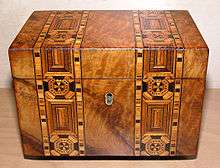 An English tea caddy decorated with wood inlay
An English tea caddy decorated with wood inlay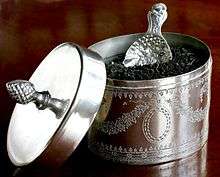 A silver plated tea caddy and a caddy spoon
A silver plated tea caddy and a caddy spoon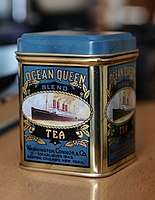 Ocean Queen old styled tea tin
Ocean Queen old styled tea tin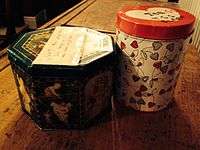 The LFB Fleet Teams Tea Caddies
The LFB Fleet Teams Tea Caddies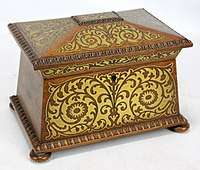 Early to mid-19th century rosewood and brass inlaid caddy
Early to mid-19th century rosewood and brass inlaid caddy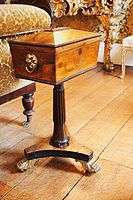 19th-century tea chest with its own stand
19th-century tea chest with its own stand
See also
References
| Wikimedia Commons has media related to Tea caddies. |
- "Tea canister". Victoria and Albert Museum.
![]()